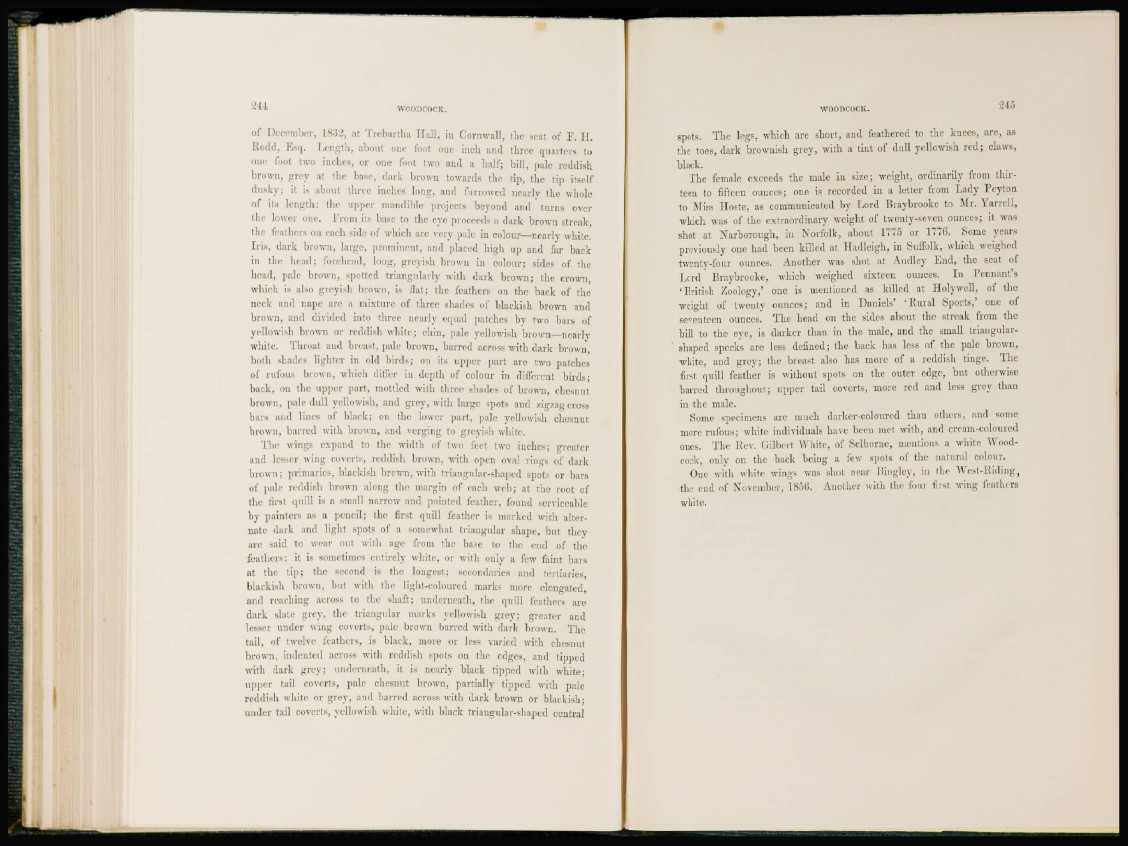
144 WOODCOCK.
of December, 1832, at Trebartha Hall, in Cornwall, the seat of F. H.
Rodd, Esq. Length, about one foot one inch and three quarters to
one foot two inches, or one foot two and a half; bill, pale reddish
brown, grey at the base, dark brown towards the tip, the tip itself
dusky; it is about three inches long, and furrowed nearly the whole
of its length: the upper mandible projects beyond and turns over
the lower one. From its base to the eye proceeds a dark brown streak,
the feathers on each side of which arc very pale in colour—nearly white.
I r i s , dark brown, large, prominent, and placed high up and far back
in the head; forehead, long, greyish brown in colour; sides of the
head, pale brown, spotted triangularly with dark brown; the crown,
which is also greyish brown, is Hat; the feathers on the back of the
neck and nape are a mixture of three shades of blackish brown and
brown, and divided into three nearly equal patches by two bars of
yellowish brown or reddish white; chin, pale yellowish brown—nearly
white. Throat and breast, pale brown, barred across with dark brown,
both shades lighter in old birds; on its upper part are two patches
of rufous brown, which differ in depth of colour in different birds;
back, on the upper part, mottled with three shades of brown, ehesnut
brown, pale dull yellowish, and grey, with large spots and zigzag cross
bars and lines of black; on the lower part, pale yellowish ehesnut
brown, barred with brown, and verging to greyish white.
The wings expand to the width of two feet two inches; greater
and lesser wing coverts, reddish brown, with open oval rings of dark
brown; primaries, blackish brown, with triangular-shaped spots or bars
of pale reddish brown along the margin of each web; at the root of
the first quill is a small narrowr and pointed feather, found serviceable
by painters as a pencil; the first quill feather is marked with alternate
dark and Light spots of a somewhat triangular shape, but they
are said to wear out with age from the base to the end of the
feathers: it is sometimes entirely white, or with only a few faint bars
at the tip; the second is the longest: secondaries and rortiaries,
blackish brown, but with the light-coloured marks more elongated,
and reaching across to the shaft; underneath, the quill feathers are
dark slate grey, the triangular marks yellowish grey; greater and
lesser under wing coverts, pale brown barred with dark brown. The
tail, of twelve feathers, is black, more or less varied with ehesnut
brown, indented across with reddish spots on the edges, and tipped
with dark grey; underneath, it is nearly black tipped with white;
upper tail coverts, pale ehesnut brown, partially tipped with pale
reddish white or grey, and barred across with dark brown or blackish;
under tad coverts, yellowish white, with black triangular-shaped central
WOODCOCK. :2 b)
spots. The legs, which are short, and feathered to the knees, are, as
the toes, dark brownish grey, with a tint of dull yellowish red; claws,
black.
The female exceeds the male in size; weight, ordinarily from thirteen
to fifteen ounces; one is recorded in a letter from Lady Peyton
to Miss Hoste, as communicated by Lord Braybrookc to Mr. Yarrell,
which was of the extraordinary weight of twenty-seven ounces; it was
shot at Narborough, in Norfolk, about 1775 or 1776. Some years
previously one had been killed at Hadleigh, in Suffolk, which weighed
twenty-four ounces. Another was shot at Audley End, the seat of
Lord Braybrooke, which weighed sixteen ounces. In Pennant's
' B r i t i sh /oology,' one is mentioned as killed at Holywell, of the
weight of twenty ounces; and in Daniels' 'Rural Sports,' one of
seventeen ounces. The head on the sides about the streak from the
bill to the eye, is darker than in the male, and the small triangularshaped
specks are less defined; the back has less of the pale brown,
white, and grey; the breast also has more of a reddish tinge. The
first quill feather is without spots on the outer edge, but otherwise
barred throughout; upper tail coverts, more red and less grey than
in the male.
Some specimens are much darker-coloured than others, and some
more rufous; white individuals have been met with, and cream-coloured
ones. The Rev. Gilbert White, of Sclborne, mentions a white Woodcock,
only on the back being a few spots of the natural colour.
One with white wings was shot near Bingley, in the West-Riding,
the end of November, 185G. Another with the four first wing feathers
white.